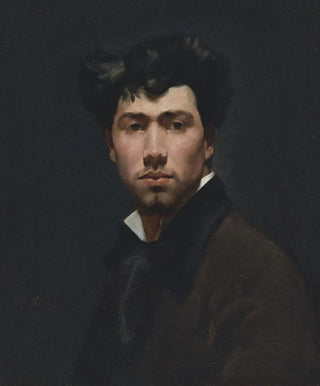Art print | Portrait of a Young Man - Giovanni Boldini


View from behind

Frame (optional)
In the fascinating world of art, some works transcend their era and continue to evoke deep emotions centuries later. The "Portrait of a Young Man" by Giovanni Boldini is undoubtedly one of these masterpieces. This painting, which captures the very essence of youth and vitality, invites you to explore not only the artist's technique but also the social and cultural context in which he evolved. Boldini, known for his flamboyant style and his ability to capture the personality of his subjects, offers us here a valuable insight into the aspirations and dreams of a bygone era.
Style and uniqueness of the work
The "Portrait of a Young Man" stands out for its bold use of color and light, characteristic of Boldini's style. The artist manages to create an effect of movement and life, almost tangible, giving the viewer the impression that the young man could come to life at any moment. The way Boldini uses brushstrokes to add texture to the clothing and fluidity to the facial features demonstrates impressive technical mastery. Every detail, from the sparkling gaze to the folds of the suit, is carefully crafted, revealing not only the subject's outer beauty but also emotional depth. This ability to blend realism with a touch of idealization is what gives the artwork its unique and timeless character.
The artist and his influence
Giovanni Boldini, born in 1842 in Ferrara, is often associated with the Impressionist movement, although his style diverges through its flamboyance and dynamism. He captured the spirit of his time, notably through his portraits of high society, which testify to a world in full transformation. Boldini was also influenced by his contemporaries, such as Degas and Manet, while developing an artistic language that is uniquely his own. His talent for representing the psychology of his subjects through elegant poses and nuanced expressions has left an indelible mark on portrait art. By exploring the "Portrait of a Young Man," one better understands how this artist transformed the way society perceived human representation, making each portrait a visual narrative.

Matte finish

View from behind

Frame (optional)
In the fascinating world of art, some works transcend their era and continue to evoke deep emotions centuries later. The "Portrait of a Young Man" by Giovanni Boldini is undoubtedly one of these masterpieces. This painting, which captures the very essence of youth and vitality, invites you to explore not only the artist's technique but also the social and cultural context in which he evolved. Boldini, known for his flamboyant style and his ability to capture the personality of his subjects, offers us here a valuable insight into the aspirations and dreams of a bygone era.
Style and uniqueness of the work
The "Portrait of a Young Man" stands out for its bold use of color and light, characteristic of Boldini's style. The artist manages to create an effect of movement and life, almost tangible, giving the viewer the impression that the young man could come to life at any moment. The way Boldini uses brushstrokes to add texture to the clothing and fluidity to the facial features demonstrates impressive technical mastery. Every detail, from the sparkling gaze to the folds of the suit, is carefully crafted, revealing not only the subject's outer beauty but also emotional depth. This ability to blend realism with a touch of idealization is what gives the artwork its unique and timeless character.
The artist and his influence
Giovanni Boldini, born in 1842 in Ferrara, is often associated with the Impressionist movement, although his style diverges through its flamboyance and dynamism. He captured the spirit of his time, notably through his portraits of high society, which testify to a world in full transformation. Boldini was also influenced by his contemporaries, such as Degas and Manet, while developing an artistic language that is uniquely his own. His talent for representing the psychology of his subjects through elegant poses and nuanced expressions has left an indelible mark on portrait art. By exploring the "Portrait of a Young Man," one better understands how this artist transformed the way society perceived human representation, making each portrait a visual narrative.






